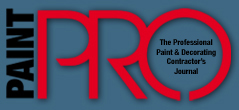
...continued from previous page
Radiant Barrier Coatings
With miles and miles of unpainted attics throughout the country, radiant barrier coatings can be a hot commodity for painting contractors seeking ways to expand their business.
by Stacey Enesey Klemenc
When shopping for a radiant barrier coating, the key number to look for is the emissivity number, says Bob Aresty, president of Solar Energy Corp. (SOLEC) in Ewing, N.J., a company that produces LO/MIT radiant barrier paints. “The closer that number is to zero, the better.”
Emissivity is the ability of a surface to radiate heat in the form of infrared radiation. “A normal roof deck of a home is made of plywood, which has an emissivity rating of .90 or higher. When you spray our product on the bottom of the plywood, the emissivity drops from .93 to .23. When you change the emissivity of the surface, it lessens its ability to radiate heat into the attic cavity.”
When you’re shopping for low-e products and comparing one to the other, Aresty cautions, make sure the products’ claims are backed by third-party testing.
In the real world, he continues, the energy savings associated with low-e paints are hard to pin down because there are so many variables to consider, such as the color of the roof, the presence of trees, how well the home is insulated and so on. “Every building is different,” he says. “But what we see in attic temperature-drops ranges from 10 to 25 degrees F. We’ve had some people report a drop as high as 40 degrees.”
In some areas of the country, homeowners are rewarded for using these products, he says. As part of a city conservation program in Austin, Texas, for instance, users receive a rebate of 7 cents for every square foot of roof. And the state of Florida has a separate section in its energy code devoted to interior radiation coatings.
According to Walters, radiant barriers don’t have a significant effect on air temperatures in well-ventilated attics. He says they are most effective in:
- Locations where there are extreme temperatures in summer;
- Homes with strong western exposure;
- Homes that rely heavily on air conditioning for occupant comfort;
- Older homes with inadequate insulation; and
- Homes with dark roofing materials.
“The coating will last as long as the substrate is kept in good, clean condition,” says Revnew. “If any areas are damaged, the coating should be reapplied to maximize the efficiency.”
Aresty notes one of SOLEC’s LO/MIT paints was recently tested to see how it held up after 13 years. “The emissivity values were still the same as the day it was installed,” he says.
“Just look at the miles of unpainted undersides of roofs that could benefit from this application. It’s all new business. If you’re quoting an interior or exterior job, throw an extra quote into the bid concerning the attic,” Walters recommends, adding that Degussa can provide you with a formula to figure out an accurate price.
Aresty agrees, adding that his company has a presentation on tape and CD to help with marketing. “You’ve already got your foot in the door. This would simply be an add-on service. It will add value to the house. And in a normal application, this product will pay for itself in five years.”
The coatings don’t support mold growth, they aren’t conductive like foil products and they don’t interfere with satellite dishes or cell phone reception. Plus, a professional painter will already have the airless sprayer necessary to apply the product, so no special investment dollars are needed.
These products offer tremendous advantages to homeowners and a good deal of potential profit to painters, Aresty says. “Painters are missing a terrific opportunity here.”

|

